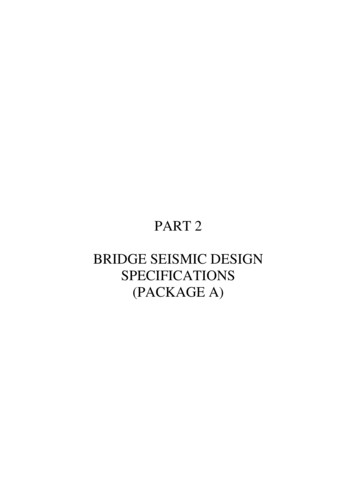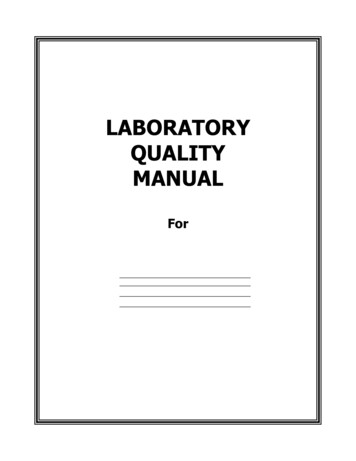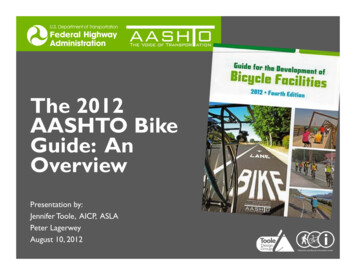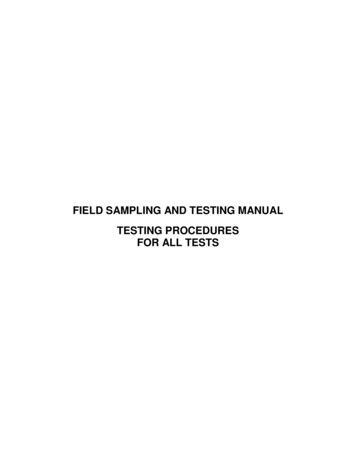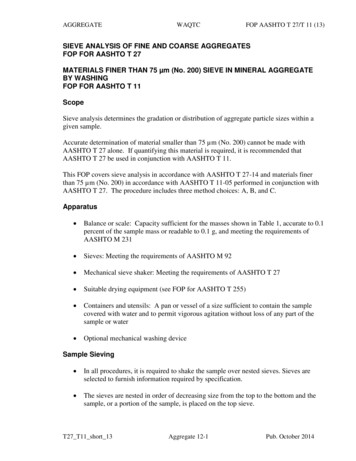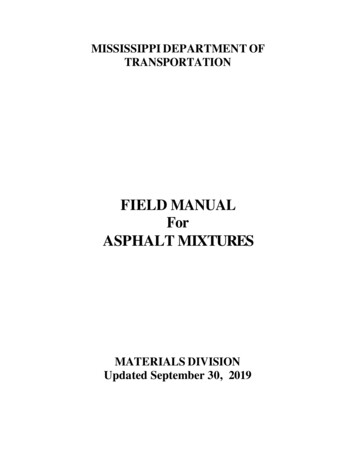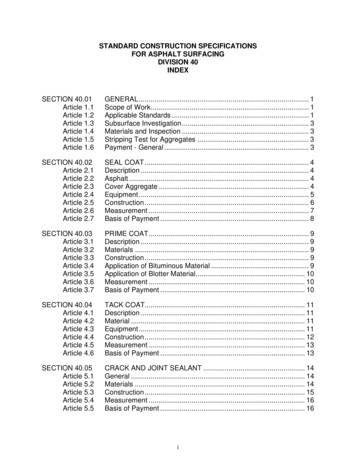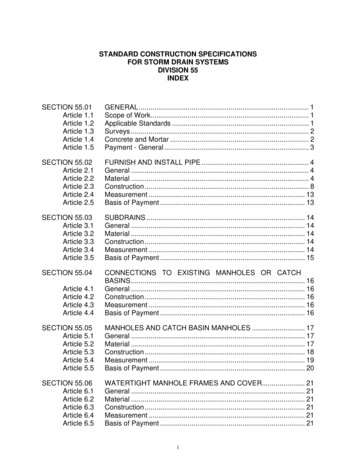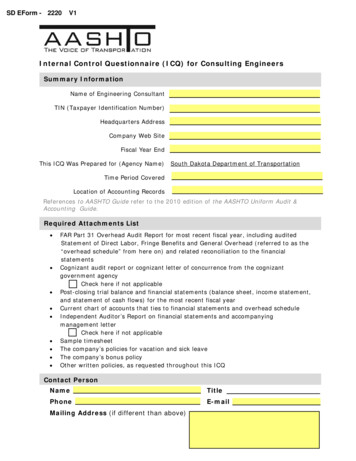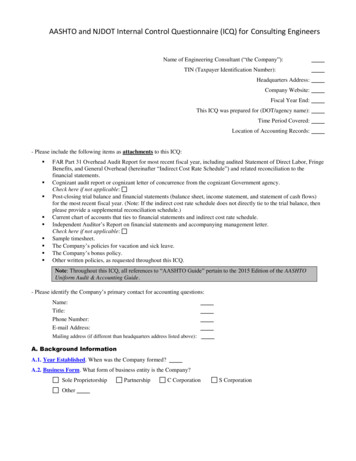
Transcription
AASHTO and NJDOT Internal Control Questionnaire (ICQ) for Consulting EngineersName of Engineering Consultant (“the Company”):TIN (Taxpayer Identification Number):Headquarters Address:Company Website:Fiscal Year End:This ICQ was prepared for (DOT/agency name):Time Period Covered:Location of Accounting Records:- Please include the following items as attachments to this ICQ: FAR Part 31 Overhead Audit Report for most recent fiscal year, including audited Statement of Direct Labor, FringeBenefits, and General Overhead (hereinafter “Indirect Cost Rate Schedule”) and related reconciliation to thefinancial statements.Cognizant audit report or cognizant letter of concurrence from the cognizant Government agency.Check here if not applicable:Post-closing trial balance and financial statements (balance sheet, income statement, and statement of cash flows)for the most recent fiscal year. (Note: If the indirect cost rate schedule does not directly tie to the trial balance, thenplease provide a supplemental reconciliation schedule.)Current chart of accounts that ties to financial statements and indirect cost rate schedule.Independent Auditor’s Report on financial statements and accompanying management letter.Check here if not applicable:Sample timesheet.The Company’s policies for vacation and sick leave.The Company’s bonus policy.Other written policies, as requested throughout this ICQ.Note: Throughout this ICQ, all references to “AASHTO Guide” pertain to the 2015 Edition of the AASHTOUniform Audit & Accounting Guide.- Please identify the Company’s primary contact for accounting questions:Name:Title:Phone Number:E-mail Address:Mailing address (if different than headquarters address listed above):A. Background InformationA.1. Year Established. When was the Company formed?A.2. Business Form. What form of business entity is the Company?Sole ProprietorshipOtherPartnershipC CorporationS Corporation
A.3. Parent/Subsidiary. Is the Company a subsidiary of any other company?If “yes,” please explain:YesNoA.4. Common Ownership. Does the Company own or control any other company or legal entity (e.g., trust or foundation)through common ownership? (See AASHTO Guide Section 8.23.B for details.)If “yes,” please explain:YesNoA.5. Ownership. Please list the stockholders, partners, or other owners with greater than five percent ownership of theCompany and their respective percentages of ownership.Table 1: Company OwnershipNameTitleOwnership Percentage%%%%%%%%%%%%A.6. Services Provided. What types of services by % does the Company provide? (i.e.: consultant–Architectural andEngineering Design, Material Testing, Borings, Traffic Control Teaching Engagements, Computer Programming et al.)a.%b.%c.%d.%A.6.1. Services Provided. What is the total annual revenue for each of the services detailed in A.6.?a.b.c.d.A.7. Locations. How many offices does the Company operate, and where are these offices located?a. Number:b. Locations:1
A.8. Number of Employees. How many employees (including managers and principals) does the Company currentlyemploy?a. Full time:b. Part time:- Has this number changed in the past one-year period?NoYes. If “yes,” please explain:A.9. Revenue Sources.1. For most recent fiscal year, what percentage of the Company’s revenue was generated from each of the following?a. State government:%c. Local government:%b. Federal government:%d. Commercial/private:%2. Please specify all revenues earned as either a prime consultant or subconsultant:a. Revenues from Government Projects: b. Revenues Other Customers: Total Company Gross Revenue:A.10. Contract Mix. What percentage of the Company’s revenue was generated from each of the following contract types?a. Lump sum:%c. Cost plus (time and materials):b. Cost plus fixed fee:%d. Other:%% Please explain “Other.”B. Accounting: General BackgroundB.1. Fiscal Period. Has the Company used the same fiscal reporting period for the past two years?YesNoB.2. Accounting Method/Basis. What basis of accounting does the Company use to prepare general purpose financialstatements?CashAccrualHybrid. Please explain “Hybrid.”- Was the same basis of accounting also used to prepare the firm’s indirect cost rate schedule?YesNo. Please explain:B.2.1. Accounting Method/Basis. Has the above basis been consistent for the past two (2) years?Yes NoB.3. Accounting Policies. Does the Company have written accounting policies that address the following topics? (If “yes,”please provide a copy.)YesNoa. Accounting system . . . . . . . . . . . . . . . . . . . . . . . . . . . . . . . . . . .b. Billing . . . . . . . . . . . . . . . . . . . . . . . . . . . . . . . . . . . . . . . . . . . .c. Cost estimating/allowability. . . . . . . . . . . . . . . . . . . . . . . . . . . .d. Recording time worked/timesheet preparation . . . . . . . . . . . . .e. Fringe benefits/leave time . . . . . . . . . . . . . . . . . . . . . . . . . . . . .f. Recording overtime . . . . . . . . . . . . . . . . . . . . . . . . . . . . . . . . . .g. Compliance with FAR Part 31(†) and applicable CAS . . . . . . . .h. Recording direct and indirect costs . . . . . . . . . . . . . . . . . . . . . .i. Overhead/indirect cost rate development . . . . . . . . . . . . . . . . .j.Billing rate development . . . . . . . . . . . . . . . . . . . . . . . . . . . . .(†)FAR Part 31 is codified at 48 CFR Part 31, which is available at l.2
B.4. Preparing the Indirect Cost Schedule. How frequently does the Company prepare an indirect cost rate schedule todetermine costs eligible for reimbursement per FAR Part 31?AnnuallyOther (please specify):- Was the most recent schedule prepared by the Company or by another entity instead (e.g., CPA firm)?Prepared by:Internal staffExternal party (specify):- Period covered by most recent indirect cost schedule:One-year period ended December 31, 20Other (please specify):B.5. Fraud, Abuse, and Contract Violations. Is the Company’s management aware of any material instances of fraud,illegal acts, abuse, or violations of contracts provisions or grant agreements?Yes. If “yes,” please explain:NoB.6. Knowledge of FAR Part 31. Are appropriate personnel within the Company familiar with FAR Part 31?No. If “no,” please explain:YesB.7. Audits/Examinations. Within the past three years, has a CPA or governmental agency performed an independent audit,review, attestation, or compilation of the Company’s financial data or any phase of the Company’s operations?NoYes. If “yes,” please complete the following (if applicable):a. Financial Statements:AuditReviewCompilationOther (please specify):Name of CPA or Agency:Contact:Period Covered:b. Overhead Rate:AuditReviewCompilationOther (please specify):- Was the overhead rate calculated in accordance with FAR Part 31?YesNoName of CPA or Agency:Contact:Period Covered:c. Project Audits:AuditReviewCompilationName of CPA or Agency:Contact:Period Covered:3Other (please specify):
C. Accounting System(s)C.1. Accounting Software. What type of accounting software does the Company use?Internally-developed system.Commercial system. Name of vendor:Hybrid system. Please explain:- Please describe any significant manual procedures used outside of the automated accounting system to record transactions:C.2. Job Costing. Does the Company have a job-cost accounting system?YesNoIf “no,” please explain what type of system is used to determine project costs:C.3. Integration. Does the accounting general ledger interface with the job-cost ledger?Yesa.N/A (no job-cost ledger used)Are billings prepared from, or reconciled to, reports generated from the Company’s job-cost system?Yesb.NoNo. Please explain:Describe any manual procedures that occur outside of the automated accounting system to preparebilling packages.C.4. Accounting Records. Which of the following types of records does the Company maintain to support financialtransactions?YesNoa. General ledger . . . . . . . . . . . . . . . . . . . . . . . . . . . . . . . . . . . . . . .b. Cash disbursements journal . . . . . . . . . . . . . . . . . . . . . . . . . . . .c. Cash receipts journal . . . . . . . . . . . . . . . . . . . . . . . . . . . . . . . . .d. Job/Project-cost ledger . . . . . . . . . . . . . . . . . . . . . . . . . . . . . .e. Labor distribution reports . . . . . . . . . . . . . . . . . . . . . . . . . . . .f. Employee expense reports . . . . . . . . . . . . . . . . . . . . . . . . . . . .g. Payroll registers . . . . . . . . . . . . . . . . . . . . . . . . . . . . . . . . . . . . .C.5. Direct and Indirect Expenses. Does the general ledger contain separate direct and indirect accounts for the following?a.b.Labor costsNon-labor expensesYesYesNoNoIf “no,” please explain:C.6. Exclusion of Unallowable Costs. Does the Company have a system in place to identify and remove from the indirectcost pools all unallowable costs, in accordance with per FAR Part 31 and applicable Cost Accounting Standards? (SeeAASHTO Guide, Sections 2.2, 4.4, 5.2, 5.5, and 6.3.)No. Please explain:Yes. If “yes,” please answer a through c, below.a. Please provide details about the system.b. How are appropriate personnel trained to distinguish between allowable and unallowable costs?c. When does the primary review for allowability occur—at time the transaction is recorded, or later?4
C.7. Divisions/Cost Centers. Does the Company have more than one division/cost center?NoYes- If “yes,” are separate ledgers maintained for each?YesNoComment:C.8. Reconciliations.a. Does the Company reconcile the financial accounting system to the job-cost system?N/A (no job-cost ledger used).No. Please explain:Check here if systems are integrated:Yes. If “yes,” how often? (Check all that t:b. How frequently are bank statements reconciled? Who performs this process?C.9. Budgeting. Does the Company use a budgeting system for project planning and oversight?YesNoComment:- If “yes,” does the Company prepare variance reports to compare budgeted amounts to actual amounts on projects,and are the reports distributed to appropriate management personnel?No. If “no,” please explain:YesC.10. Cost Allocation. Does the Company use cost allocation methods consistently for all contracts, including commercialcontracts as well as for State and Federal government contracts?(See AASHTO Guide, Sections 5.3 and 10.5.)YesNo. If “no,” please explain:C.11. Allocation Base(s). When computing indirect cost rates, the Company uses—a single base for cost allocation.Description of base:multiple bases for cost allocation.Description of bases:(See AASHTO Guide Section 4.7 for a discussion of common allocation bases for indirect costs.)C.12. Field Offices. Does the Company have field offices? (See AASHTO Guide Section 5.6.)NoYes. If “yes,”a. Are separate indirect cost rates used for the home office and field offices?YesNoPlease explain:b. If home office and field office indirect cost rates are computed, are they presented consistently toall State DOTs?YesNo. If “no,” please explain:Please check here if not applicable:5
C.13. Project-Specific Indirect Cost Rate(s). Does the Company have any special, project-specific indirect cost ratesnegotiated with a State DOT?NoYes. If “yes,” please explain, and list the States that use these rates:D. Information Technology (IT) SystemsD.1. IT Policies. Does the firm have written IT system policies concerning the following topics?(If “yes,” please provide a copy.)a.b.c.d.Hardware/SoftwareYes Purchasing . . . . . . . . . . . . . . . . . . . . . . . . . . . . . . . . . . . . . . . . . . . . . . . . Inventory . . . . . . . . . . . . . . . . . . . . . . . . . . . . . . . . . . . . . . . . . . . . . . . . . Maintenance . . . . . . . . . . . . . . . . . . . . . . . . . . . . . . . . . . . . . . . . . . . . . . Access . . . . . . . . . . . . . . . . . . . . . . . . . . . . . . . . . . . . . . . . . . . . . . . . . . . Use of In-house and off-site . . . . . . . . . . . . . . . . . . . . . . . . . . . . . . . . . . Addition and removal/retirement/disposition of . . . . . . . . . . . . . . . . . . .Business Continuation Plan . . . . . . . . . . . . . . . . . . . . . . . . . . . . . . . . . . . . . . . . . .Security Protocol . . . . . . . . . . . . . . . . . . . . . . . . . . . . . . . . . . . . . . . . . . . . . . . . . .Activation and deactivation of employees upon hiring or termination. . . . . . . . .NoD.2. IT Risk Assessment. Has the Company’s management conducted an IT system risk assessment within the past threeyears?YesNoD.3. IT Security Review. Are system security and application access logs enabled and reviewed periodically?YesNoComment:D.4. IT Electronic Data Safeguards. If documents are retained in electronic format, are they stored in a format that cannoteasily be modified, removed, or replaced, and does a mechanism/audit trail exist to track all such events?YesNoComment:6
E. Accounting – Payroll and TimekeepingE.1. Payroll Service. Does the Company use an external payroll service?NoYes. If “yes,” please specify:E.2. Pay Cycle. What is the Company’s standard pay cycle?Bi-weeklyMonthly1st & 15thOther (please specify):If the Company uses more than one pay cycle, please explain:E.3. Payroll Register. Does the payroll register include the following data?Yesa. Employee Name. . . . . . . . . . . . . . . . . . . . . . . . . . . . . . . . . . . . .b. Employee ID number. . . . . . . . . . . . . . . . . . . . . . . . . . . . . . . . .c. Gross pay . . . . . . . . . . . . . . . . . . . . . . . . . . . . . . . . . . . . . . . . . .d. Payroll deductions . . . . . . . . . . . . . . . . . . . . . . . . . . . . . . . . . . .e. Net pay . . . . . . . . . . . . . . . . . . . . . . . . . . . . . . . . . . . . . . . . . . . .f. Check amount . . . . . . . . . . . . . . . . . . . . . . . . . . . . . . . . . . . . . .g. Hourly rate . . . . . . . . . . . . . . . . . . . . . . . . . . . . . . . . . . . . . . . . .h. Pay period . . . . . . . . . . . . . . . . . . . . . . . . . . . . . . . . . . . . . . . . .i. Normal hours for pay period . . . . . . . . . . . . . . . . . . . . . . . . . . .j. Overtime hours for pay period . . . . . . . . . . . . . . . . . . . . . . . . . .NoComments:E.4. Timekeeping System.a. Does the Company use an electronic timekeeping system?YesNo- If “yes,” please provide an explanation of its operation, or provide system documentation:b. Are all employees, including managers and owners/principals, responsible for signing their own timesheets?YesNoIf “no,” please explain:c. Are all employee timesheets approved by supervisors?YesNoIf “no,” please explain:d. Is there a certification and approval process required for all time worked by owners and principals?YesNoIf “no,” then how is time accounted for and billed to projects?e. How are timesheet coding errors detected and corrected?f. How do timesheets identify work performed outside an agreement’s original scope of services?7
F. Labor Cost AccumulationF.1. Direct & Indirect Labor. Do the Company’s timesheets include reporting codes for both direct and indirect hours? (SeeAASHTO Guide, Chapter 6.)YesNo- If “yes,” do all employees, including managers and principals, record direct and indirect time on theirtimesheets?- If “no,” then please explain the method used to segregate direct and indirect labor hours.F.2. Work Week. Please list the Company’s normal hours of business operation (normal work week):F.3. Uncompensated Overtime (see AASHTO Guide, Section 5.4). Does the Company record all hours worked by allemployees, including managers and principals, regardless of whether the employees are exempt from overtime pay orwhether all direct labor hours are billed to specific contracts?No. If “no,” please explain:Yes. If “yes,” which of the following methods does the Company use to account for uncompensated overtime—the hours worked without additional compensation in excess of an average of 40 hours per week by direct-chargeemployees who are exempt from the Fair Labor Standards Act?Effective Rate Method. Please explain:Salary Variance Method. Please explain. (E.g., What was the total dollar amount ofthe salary/payroll variance for the year?): Other. Please explain:F.4. Contract Modifications/Time Tracking. How does the Company segregate work performed under a basicagreement/contract from work performed for contract changes/modifications?8
G. Labor Billings and Project CostingG.1. Billing Rates. Please describe how billing rates are determined, or attach the Company’s billing-rate policy.Description:Billing-rate policy attached.G.2. Premium Overtime. Does the Company pay overtime at a premium to any employees?YesNo- If “yes,”a. What premium rate is paid, and what categories of employees are eligible for this rate?Time-and-a-half for all non-exempt employees.Other. Please explain:b. How is the overtime premium accounted for and billed?As part of direct labor, and overhead is applied.As an Other Direct Cost (no overhead applied).As an indirect labor cost (included in the indirect cost rate).Other. Please explain:G.3. Allocation of Overtime Costs. Are overtime costs allocated to contracts consistently, regardless of the type of contract(lump sum versus actual cost) or customer (government versus commercial)?No. If “no,” please explain:YesG.4. Cost Allocation versus Billing. If the Company pays a principal or an employee at a rate in excess of a contract’smaximum hourly labor rate, where will the excess cost be allocated/charged?G.5. Contract/Purchased Labor. Does the Company invoice/bill contract labor directly to any customers?YesNoN/A- If “yes,” please complete the following: Contract labor is billed—As part of direct labor, and overhead is applied.As an Other Direct Cost (no overhead applied).Other. Please explain:9
H. Expense Accumulation and BillingH.1. Nonsalary Direct Costs (Other Direct Costs). Besides labor, what type of costs does the Company normallybill/invoice as direct expenses?H.2. Credits Associated with Direct Costs. Is the indirect cost pool relieved/reduced for credits/reimbursements receivedfor direct costs?YesNo. If “no,” please explain:H.3. Design/Build Stipends. Has the Company received a stipend from any State DOT in connection with design/buildefforts?YesNo- If “yes,” please explain how the Company accounted for the stipend in the accountingsystem:H.4. Classification of Cost Items. How are the following cost items accounted for and billed?(Check both “D” and “I,” if applicable.)(D Direct; I Indirect; N/A not applicable)DIa.b.c.d.e.f.g.h.i.j.k.N/AVehicles . . . . . . . . . . . . . . . . . . . . . . . . . . . . . . . . . . . . . . . . . . . . . . . . . .Computer Assisted Design and Drafting (CADD) . . . . . . . . . . . . . . . . .Computer (non-CADD) . . . . . . . . . . . . . . . . . . . . . . . . . . . . . . . . . . . . . .Telephone . . . . . . . . . . . . . . . . . . . . . . . . . . . . . . . . . . . . . . . . . . . . . . . .Printing / Reproduction . . . . . . . . . . . . . . . . . . . . . . . . . . . . . . . . . . . . . .PostageLabDrillingTravel and SubsistenceGPS and/or Nuclear Density MetersOther (list if significant)H.5. Nonbillable Costs. Describe the accounting treatment for direct costs not billable to clients. (Where/how are these costsrecorded?)H.6. Authorization. How does the Company ensure that costs are not billed to Government projects prior to properauthorization?H.7. Vehicle Expenses. Does the Company provide vehicles to employees for business purposes?YesNoa.If “yes,” are the vehicles leased or owned?LeasedOwnedb.Identify the total number of vehicles owned or leased by the company.LeasedOwnedc.Are mileage logs maintained for all vehicles? If “no,” please explain below.YesNoExplanation:10
d.Is mileage separated by direct and indirect classifications, and is mileage incurred in connection withunallowable activities tracked?YesNoExplanation:e.What recovery/billing rate is used for Company vehicle mileage reimbursement? per mile.Explanation:f.How was the rate developed?H.8. Computer Expenses. Are the Company’s computer expenses incurred as a result of (select one):a.b.c.d.Outside Services?Company ownership?Does the Company compute a charge rate for computers?- If “yes,” what is the rate?- How was the rate developed?Is computer usage segregated by direct and indirect classifications?Are computer usage logs maintained and coded by job/project?Both?YesNoYesYesNoNoH.9. Printing and Reproduction Costs. How are printing and reproduction expenses treated?- In House:Direct costIndirect costCombination of direct and indirect- Outside vendor:Direct costIndirect costCombination of direct and indirectIf you marked “combination of both,” please explain:a.For in-house services, are usage logs maintained and coded by job/project?Yesb.Is usage segregated by direct and indirect classifications?Yesc.NoNoIf these costs are incurred through the use of an outside vendor, are the invoices coded by job/project whenreceived?YesNoH.10. Telephone Costs. How is the expense for telephone service recorded and billed?Direct costIndirect costCombination of direct and indirectIf you marked “combination of direct and indirect,” please explain below:- Does the Company maintain a telephone log to record toll calls?YesNo- Are the calls job-coded by direct and indirect classifications?YesNo11
H.11. Activities Ineligible for Cost Reimbursement. Did any of the Company’s employees engage in activities forlobbying, advertising, public relations, charity, and/or entertainment?- If “yes,” please list the employees who engaged in these activities, and describe how the associated costswere tracked and accounted for in relation to the submitted indirect cost rate.Table 2: Unallowable ActivitiesEmployee Name or ID &Title/Classification:Activities:Accounting Treatment:I. Compensation for Owners and EmployeesI.1. Bonuses.a.Did the Company pay, or accrue for, bonuses earned by owners or employees during the period covered by the latestindirect cost rate schedule?YesNo- If “yes,” were the bonuses included in the submitted overhead rate?YesNoN/A- Was any portion of these bonuses excluded from the submitted overhead rate?YesNoN/AComment:b.Does the Company have a written bonus plan?Yes. Please provide a copy of the plan.No. Please describe how bonuses are determined and how this is communicated to employees.c.Are all employees eligible for the bonuses?No. If “no,” please explain:YesI.2. Executive Compensation. Has the Company, an independent CPA, or compensation consultant performed an evaluationof executive compensation for reasonableness in accordance with FAR 31.205-6? (See AASHTO Guide Section 7.5.)YesNo- If “yes,” describe the methodology used and how this process has been documented:12
J. Related-Party TransactionsJ.1. Related Employees. Please provide the following information for all employees who are related to the parties listed inthe Ownership Table (Table 1) shown in A.5:Table 3: Employees Related to Company OwnersName or ion:Compensation: 12345678Total HoursWorked DuringYear:Total HoursWorked DuringYear:Total HoursWorked DuringYear:Total HoursWorked DuringYear:Total HoursWorked DuringYear:Total HoursWorked DuringYear:Total HoursWorked DuringYear:Total HoursWorked DuringYear:Bonus:Job Duties:Related to:How Related (e.g., spouse, parent, child, sibling, in law):Job Duties:Related to:How Related:Job Duties:Related to:How Related:Job Duties:Related to:How Related:Job Duties:Related to:How Related:Job Duties:Related to:How Related:Job Duties:Related to:How Related:Job Duties:Related to:How Related:13
Name or ID:910Total HoursWorked DuringYear:Total HoursWorked TotalCompensation:Compensation: Job Duties:Related to:How Related:Job Duties:Related to:How Related:J.2. Related Vendors. Please provide the following information for all vendors related to the parties listed in the OwnershipTable (Table 1) shown in A.5:Table 4: Vendors Related to Company OwnersName:Contact Information:How Related:Products/Services Provided:Total PaymentsDuring Year: 14
J.3. Property or Facilities Leased from Related Parties. Does the Company rent or lease property and/or facilities fromanother entity (organization or individual)?YesNo- If “yes,”a. Are any of the Company’s owners/stockholders, or members of their immediate family, alsoowners/stockholders of the other entity?YesNo- If “yes,” please explain:b. Have the rental/lease costs been adjusted to the property owner’s actual costs?YesNo- If “yes,” what basis was used to determine actual cost? (E.g., the property owner’s tax returninterest expense, plus cost of money).Description:lessJ.4. Other Related-Party Transactions. Did the Company engage in any transactions with related parties other than thoselisted and described in J.1 through J.3?NoYes. If “yes,” please complete Table 5:Table 5: Other Related-Party TransactionsName:Contact Information:How Related:Products/Services Provided:Total PaymentsDuring Year: 15
K. Other QuestionsK.1. Life Insurance. Does the Company pay life insurance for officers/principals?YesNo- If “yes,”(a) Have any costs associated with this life insurance been included on the indirect cost rate schedule?Yes total amount:No(b) Please identify the beneficiary of the life insurance:Company/surviving partnersOfficer/principal’s familyOther (specify)(c) Please identify the type(s) of the life insurance:TermWhole lifeUniversal lifeAccidental deathOther (please specify):Endowments (annuities)K.2. Suspension or Debarment. Has the Company, its parent, subsidiary, or any owner, stockholder, officer, partner, oremployee of the Company been suspended or debarred from doing business by any State or the Federal government?YesNo- If “yes,” please provide complete details:K.3. Updates for Changes to FAR Part 31. Does the Company have an existing process designed to provide timely updatesto company policies and procedures to accommodate changes in the FAR Subpart 31.2 cost principles?YesNo- If “yes,” please describe the process:K.4. Risk Assessment. Does the Company have a process for assessing risks that may result from changes in cost accountingsystems or processes?YesNo- If “yes,” please describe the process. How are risks identified and addressed?K.5. Communications of FHWA/DOT Requirements. How does information flow from the FHWA/State DOT toappropriate management personnel? (E.g., How are relevant updates to State DOT procedures or Federal Regulationsdisseminated to project managers and accounting personnel?)16
K.6. Contract Type Experience. In the past two years, how much experience has your Firm had with the following contracttypes?Number of contracts orPercentage of total contractsCost Plus Fixed Fee:Fixed Price:Hourly Rate:Other please specify:K.7. Previous Contracts with NJ DOT. Has your firm had any previous contracts with the Department?YesNoIf "Yes", was this contract as a Consultant?YesNoIf you checked “Yes” please provide the executed date of most recent agreement:Were you a Subconsultant? If so, please indicate name of Consultant:K.8. Other Employment. Are any of the individuals who are employees of your firm also employees of other firms?YesNoIf you indicated “Yes”: Affiliated companyNon-related companyK.9. Labor Categories. Does your firm use any of the following labor categories?Employees from affiliatesPart time employeesJob shoppersYesYesYesNoNoNoIf yes to any of the above, please detail how they are treated in your accounting system:K.10. Accounting Records. Describe your firm's policy regarding the retention of accounting records including timesheets,expense vouchers and canceled checks. (attach a separate sheet, if necessary)17
K.11. Direct Non-Salary Expenses Which of the following direct non-salary expenses does your firm wish to bill directlyto the Department?A.B.C.D.E.F.G.Vendor invoiced costSubsistenceLong distance telephoneEmployee vehicle mileageCompany vehicle mileageIn-house reproductionsIn-house teRateRateRateK.12. Direct Non-Salary Expenses. What source documents will be used to generate labor and expense billings to theDepartment?K.13. Direct Non-Salary Expenses. Has any officer or partner of your organization ever failed to complete a consultantcontract handled in his/her own name?YesNo.If you answered "yes", state name of individual, name of owner, type of consultant contract and reason for failure to completethe contract.I hereby certify that the foregoing information and any attachments thereto are true, accurate, and consistent with the recordsmaintained by the individual, partnership, or corporation submitting this Cost Basis Contracting Questionnaire. Iacknowledge that the New Jersey Department of Transportation is relying on the information contained herein and I amaware that any false statement or misrepresentation may subject me and/or my firm to criminal penalties.Typed or Printed NameSignatureTitleDate CompletedNote: The representations on this ICQ were made by, and are the responsibility of, the Company’s management.18
Documents Required for Cost Basis ApprovalTimesheet – Timesheets may be prepared on a weekly, bi-weekly, or monthly basis preferablycoinciding with the firm’s pay period. The employee timesheet should show total hours worked byproject number. Also, all indirect hours worked or leave time used by an employee should beclearly indicated on the employee’s timesheet. Employee and supervisory approval signaturesshould be included on the timesheet.Employee Expense Report – A completed Employee Expense Report or its equivalent, whichidentifies direct and indirect non-salary expenses by project number or indirect number. The type ofcosts that should be on the Employee Expense Report are out-of-pocket expenses incurred
Note: Throughout this ICQ, all references to “AASHTO Guide” pertain to the 2015 Edition of the AASHTO Uniform Audit & Accounting Guide. - Please identify the Company’s primary contact for
